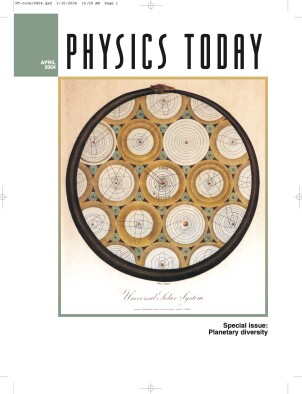In Brief
DOI: 10.1063/1.2408552
In a ceremony this spring at his official residence, president of Mexico Vicente Fox is presenting Constantino Tsallis with the 2003 Mexico Prize for Science and Technology, which includes a medal and a cash prize of 440 000 Mexican pesos (about $40 000). Tsallis, who heads the department of condensed matter and statistical physics at the Brazilian Center for Research in Physics in Rio de Janeiro, is being cited for his proposal of, and work on, the generalization of the Boltzmann–Gibbs statistical mechanics. The award is given annually by the Mexican government to one person from the Caribbean, Central or South America, Portugal, or Spain (Mexico is excluded) “of recognized professional prestige who has significantly contributed to universal scientific knowledge or to technological advances or to the development of the social sciences.”
Chris Walter joined Duke University’s physics department in January as an assistant professor; he is starting a new neutrino physics group with Kate Scholberg. Walter previously was a research assistant professor in the physics department at Boston University. Scholberg will arrive in September to take her post as assistant professor on the Duke faculty, leaving her position as Mitsui Career Development Professor at MIT.
At a ceremony in London in January, Edouard Brézin, who is a member of the Laboratoire de Physique Théorique at the Ecole Normale Supérieure, received this year’s President’s Medal from the UK’s Institute of Physics. The award acknowledged his “distinguished international reputation in theoretical physics, and his leadership of science” as chairman of the physics department of the Ecole Normale Supérieure (1986–91), chairman of the board of CNRS (1992–2000), and in his present posts as vice-president of the Académie des Sciences and president of the French Physical Society.
David Grier joined New York University in December as a professor of physics and became the inaugural member of the university’s Center for Soft Matter Research. He left a position as a professor of physics with the University of Chicago, where he had been on the faculty since 1992.
In October, Arthur Ramirez became director of the condensed matter physics research department at Lucent Technologies’ Bell Labs in Murray Hill, New Jersey. Ramirez, who also joined Columbia University as an adjunct professor of applied physics and applied mathematics, was previously the group leader of the materials integration science laboratory at Los Alamos National Laboratory.
Andrew K. Rogers began his new position last October as a senior scientist/senior oceanographer with the Woods Hole Group in East Falmouth, Massachusetts. He is responsible for, among other tasks, managing scientific research, consulting, and technical support efforts in applied information technology, including remote sensors and acoustics. He was formerly senior principal scientist with Planning Systems Inc in Reston, Virginia.
